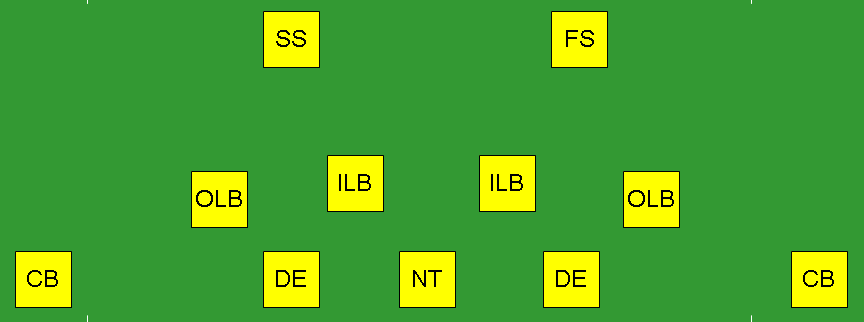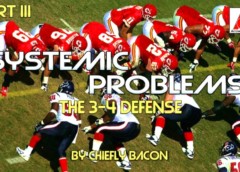
Systemic Problems- Part III:
The 3-4 Defense • by Ransom Hawthorne

Read “Systemic Problems- Part I: West Coast Offense” –> here.
Read “Systemic Problems- Part II: Zone Blocking” –> here.

I’m a big fan of the 3-4 defense. It‘s one of the most diverse defensive systems there is. There are many offshoots in the execution and strategy as coaches have branched out from the original strategies governing the system. The trouble with the 3-4 defense is, that it is growing harder and harder to run effectively in today’s NFL. While the Kansas City Chiefs seem to have righted the ship somewhat on defense — for now — their early season struggles reveal some of the key challenges that the 3-4 faces.



Key Personnel- DL: The DL required for a 3-4 can vary based on who’s running it. For example, when Romeo Crennel was the DC, the Chiefs went for very tall DEs because they were using traditional two-gap techniques (where a DL is responsible for his man and the two gaps on either side of him). Current DC, Bob Sutton, originally came to K.C. with an attacking 3-4 defense, where each defender was only responsible for a single gap. In this system, strength, get-off, and speed, are much more important than raw size and length. Players like Rakeem Nunez Roches and Allen Bailey exemplify this prototype. More recently though, Sutton has switched back to big men in the middle, due to the amount of nickel and Dime-Defense the Chiefs have been running. The variety of looks the Chiefs employ makes it relatively easy to find DL who can play in their scheme, but it also means that they don’t have a clear identity along the defensive line. Sometimes depth players are stuck taking snaps in a defensive alignment that’s not suited to their strengths.

Key Personnel- CBs: A 3-4 can play a variety of coverage schemes, but K.C. employs almost exclusively, man coverage. Man coverage requires DBs who are very technically sound, with decent size and speed. That stands in contrast to zone CBs, who need to exhibit awareness and burst, but need not have great long speed or exceptional agility. Quality man coverage CBs are hard to come by. With NFL officiating slanting more and more towards the offense, it has become much harder to employ the type of physical coverage necessary to win man to man. Back in 2013, Terrence Mitchell would’ve been a shut down CB. Today, he’s a decent CB, but can draw a lot of penalties. Quality man coverage CBs are mostly found in the upper two rounds now. This is a challenge when it comes to building depth, because you need at least three good starting CBs and a pretty solid depth guy. Due to the differences in man and zone coverage, it’s also much harder to find quality nickel backs for man coverage.

Key Personnel- ILBs: Finding quality ILBs in a 3-4 can be tricky. The 3-4 employs two different linebackers on the inside. The weak-side linebacker, or Will, is Derrick Johnson’s spot. It requires a very diverse skill set. The Will must be able to cover TEs and RBs, fill gaps in the run game, play zone coverage behind the line, and, occasionally, rush the QB. The Will is also traditionally the guy who makes defensive calls and adjustments at the line, so he’s essentially the coach-on-the-field for the defense. This requires a special player. He has to be fast, agile, big, strong and have a very high football IQ. Starting Will LBs are very difficult to find, and generally go in the top two rounds, but teams have found success drafting guys with the necessary physical skills, and coaching them up (Kevin Pierre Louis could be one of those guys). The strong side ILB, or Mike linebacker, is a much easier position to fill. He simply has to read the offense well, and aggressively fill gaps. In the scheme originally employed by Sutton, the Mike didn’t even have to read, he had a predetermined gap to fill.

Key Personnel- OLB: This is the position that every 3-4 defense hinges on and the job requirements are daunting. A good OLB has to rush the passer against guys who are much bigger than they are, cover TEs, shed blocks from OTs to set the edge and drop into zone coverage. By definition, these guys are freaks. Back when the 3-4 was originally invented, covering TEs and RBs was a lot easier. With today’s athletes at RB and TE, the OLBs job has become nearly impossible. Players who can actually do all the things an OLB is supposed to do, coming out of college, are drafted in the top 5 picks. Good teams generally compensate for this by drafting players lower in the first — like Dee Ford — and relying on strong play from their secondary.

3-4 Scheme Issues: Bob Sutton’s 3-4 requires: great CBs, OLBs, and an elite WILB. All of those positions need to be drafted high in the draft. WILBs are not cost prohibitive in free agency, but CBs and OLBs generally are. While the 3-4 can be incredible when you have all these pieces, as the Chiefs did in 2015, it’s very difficult to maintain such high quality personnel. Sutton has been able to scheme around the weaknesses, but without the right personnel, it always opens up something else.

Early this year, Sutton played a ton of nickel and dime D. This helped cover up weak play at CB, but left the Chiefs constantly weak in the run D. Early in his time with the Chiefs, Sutton played a ton of press coverage and exotic blitzes. This was to cover up weak play at S. Chiefs came up with a lot of turnovers and stops, but also gave up a lot of big plays. When K.C. doesn’t have to cover up any weaknesses, they have one of the best defenses in the NFL, but since 2013, there’s only been one year where that was true. Sutton is a good coach, in that he does a good job of scheming around his weaknesses, but his inability to consistently field a quality D… personnel wise… despite a greater investment in the defense than the offense in most drafts, reveals systemic problems with the 3-4 defense in the modern NFL.

What Does This Mean For The Chiefs?
All the success the Chiefs have had is making it difficult to maintain the defensive personnel they need to make the system succeed. Bob Sutton wants to run press coverage, man defense, with a single high safety. The fact that he doesn’t often do that anymore, reveals the depth of Chiefs roster issues. While a few whiffs on CB and OLB, in the draft, have certainly hurt, fans can’t expect the team to consistently hit on those positions outside the first couple rounds, or in the case of OLB, outside the first ten picks. Simply put, it’s really tough to be a team with a winning record every year and a quality 3-4 defense. The fact that the WCO and ZBS require Chiefs to retain a lot of players on the offense, only compounds this issue.

Solution: Switch To a Hybrid Defense

Bob Sutton is never going to abandon the 3-4 entirely, but he can take care of some of the personnel issues by running some 4-3 looks. The beauty of the 4-3 is it’s simplicity. Players are responsible for individual gaps and they don’t do a bunch of reading and reacting, they just go. While 4-3 DEs and 3-4 OLBs share similar physical characteristics, 4-3 DEs almost never have to drop in coverage. This means that the Chiefs can take a raw prospect, like Kpassagnon, and play him as a pass rusher, without having to worry about dropping him in coverage.

If the Chiefs fired Bob Sutton, a possible move to a 4-3 defense with zone coverage could happen, but it would mean a major rebuild. Chiefs best ILB looks to be Reggie Ragland right now (Chiefs got him because Buffalo switched to a 4-3 and he wasn’t a fit for their scheme). Rather than completely abandoning the 3-4, I would like to see Chiefs gradually transition to more 4-3 looks with zone coverage behind them (maybe 15-25% of their snaps). I think Marcus Peters, in particular, could actually be more useful in zone, he‘d definitely have more chances to get his hands on the ball.

Systemic Problems- Conclusion
Most of the Chiefs issues, on offense and defense, stem from the inability to maintain a consistently talented roster. When John Dorsey was GM, they were more focused on the fact that he was finding replacements, than they were on the fact that he was losing players. Sure, Chiefs replaced Rodney Hudson with Mitch Morse, and it worked great, but it’d be even better to have both. The bottom line is, Chiefs run three very demanding schemes. If you try to be perfect in every area, you tend to wind up not good at much. Kansas City needs to settle on at least one of their schemes to simplify. Change from the complex WCO… shift to a power blocking run scheme… or modify their defense to require less talented role players. If the Chiefs maintain all three schemes, I think they’ll continue to have issues with roster depth.



If you are viewing this in Apple News and would like to join the Discussion, [GO HERE.](http://arrowheadone.com/systemic-problems-part-iii-the-3-4-defense/#disqus_thread)

